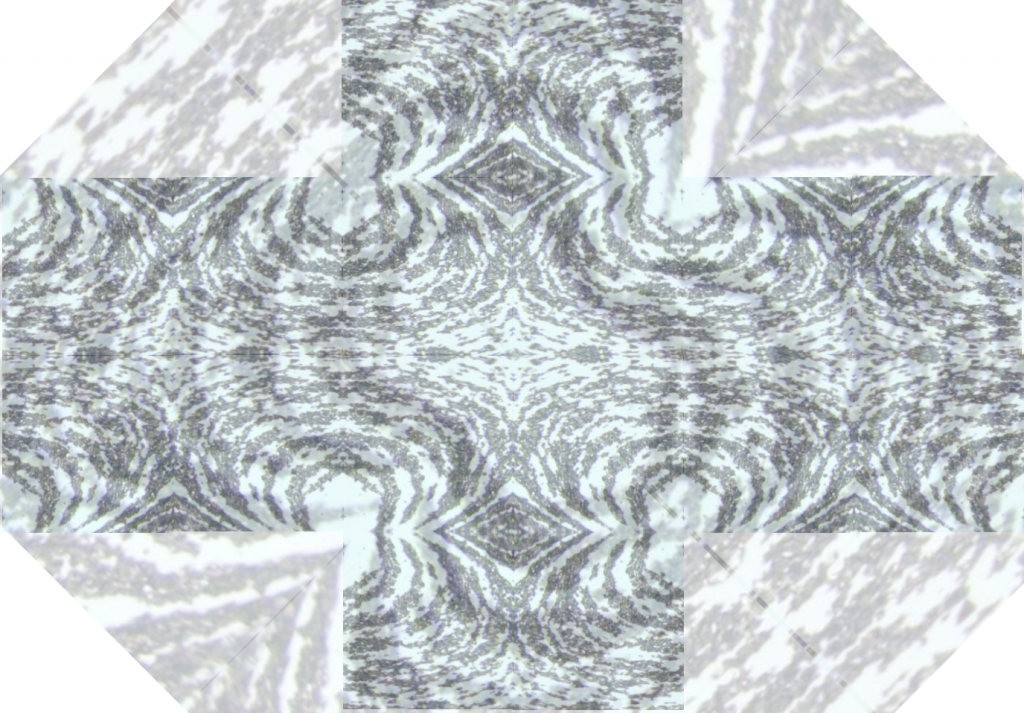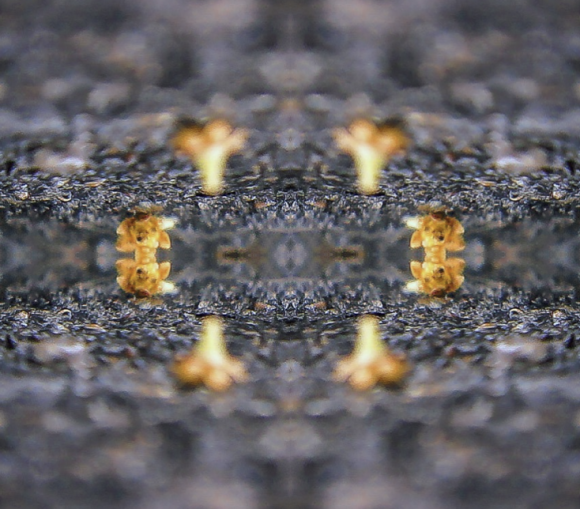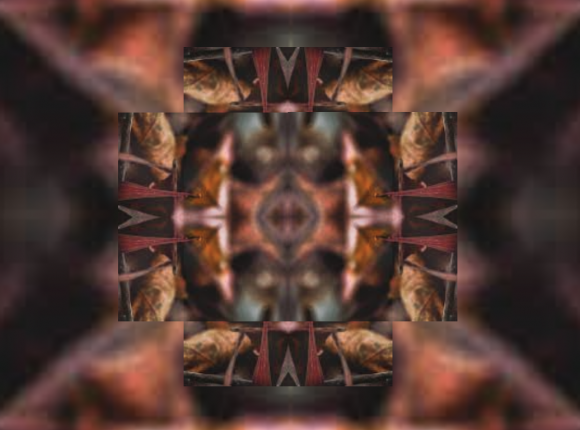In the synchronicities essay Jung refers us to his earlier article on Der Geist der Psychologie [reprinted later as Theoretische Überlegungen zum Wesen des Psychischen, found in GW VIII]. He states that there he has “presented synchronicity as a psychically conditioned relativity of space and time” (GW VIII, §840). The relevant passage must be §§440-441 in GW VIII (two very long paragraphs); it is not part of the essay itself, but from an Afterword, which is mostly polemical in nature. But it may still help somewhat to understand what Jung meant by his idea of the relativity of psychological time.

1. In the lead-up to this passage, Jung takes up a topic he has discussed at length in the essay beforehand: whether the archetypes of the collective unconsciousness should be taken as entirely psychological in nature, or as partly (or even fully) non-psychological. Famously, Jung’s view is that archetypes are the latter:
The […] effective units of the unconscious, namely the archetypes, […] have a nature which cannot with certainty be called psychological.
Die […] Wirkungseinheiten des Unbewußten, nämlich die sogenannten Archetypen, haben […] eine Natur, die man nicht mit Sicherheit als psychisch bezeichnen kann.
GW VIII, §439; Jung’s emphasis.
The reasoning that leads to this statement is long and at times obscure. But for my current purposes, I’m not interested in how plausible it is. Let’s assume, for the sake of argument, that Jung is right about this, and see what role he wants to assign, on the basis of it, to synchronistic phenomena.
2. The first step is to clarify the relationship between archetypes, whatever their nature, and phenomena which are with certainty psychological in nature.
Archetypes appear in observation and experience by arranging ideas [Vorstellungen], which happens unconsciously and can therefore be recognized only subsequently. They assimilate idea material, which indisputably originates in the phenomenal world, and become thereby visible and psychological.
Archetypen erscheinen erst in der Beobachtung und Erfahrung, nämlich dadurch, daß sie Vorstellungen anordnen, was jeweils unbewußt geschieht und darum immer erst nachträglich erkannt wird. Sie assimilieren Vorstellungsmaterial, dessen Herkunft aus der Erscheinungswelt nicht bestritten werden kann, und werden dadurch sichtbar und psychisch.
GW VIII, §440, Jung’s emphasis.
We can perhaps best understand this from an analogy: Take a magnetic field. As such, it is not visible; but in a certain sense, we can make it visible by observing its effect on metal filings. What happens when we bring a magnet close to a heap of filings is that they are arranged in a characteristic pattern. Now what we see is still not, strictly speaking, the magnetic field itself, we can only infer that it is there, and what structure it has (where the force lines run, and how they are shaped). We observe something invisible, indirectly, by its effects.
Jung seems to have thought of something like that when he described the relationship between archetypes (the magnetic field) and phenomena arranged by them (the filings), such as ideas, thoughts, emotions, and the like, in a subject. Only the latter are psychological, and from the particular way they are arranged, we can infer the impact of an archetype. The subject is of course only aware of their ideas, since these are conscious. The subject is neither conscious of the archetype itself, nor of its activity of ‘arranging’ ideas (that activity is unconscious).
But from this, it does not yet follow that the archetype itself is not psychological in nature. So far, in this picture, it is merely assigned to the unconscious. And since there is an unconscious part of the psyche as well as a conscious one, according to Jung, the archetypes, so described, could still be entirely psychological in nature.
3. The next step in the argument, therefore, must be to add further evidence which would require us to posit a non-psychological aspect of archetypes as well (ibd, still §440). This evidence, Jung says, comes from synchronistic phenomena.
Now we have seen that Jung has a rather wide notion of synchronistic phenomena. What he has in mind here seems to be primarily ‘telepathy’. He quickly dismisses any supernatural explanation for phenomena usually called ‘telepathic’, but insists that they are nonetheless factual. Characteristically, he does this by an ad hominem claim: If you don’t believe it, you’re prejudiced (ibd, still §440).
(I have already noted that I wouldn’t myself count telepathy, factual or not, under any usable notion of ‘synchronicity’. But Jung does, and in contrast to my own view, he also believes that telepathy has been experimentally demonstrated. So in order to understand his argument here, I will grant this premise, for the sake of argument, as well.)
Why, then, would the existence of telepathy entail that archetypes are non-psychological in nature?
4. The short answer is: because archetypes exist outside space and time.
5. Let’s unpack this a little.
In Jung’s view, the collective unconscious has a special kind of reality. (The collective unconsciousness is, of course, roughly the set of archetypes, along with their interrelations, insofar as these are also archetypal.) It forms a separate realm, apart from the spatiotemporal world of physical objects, and apart also from the psychological world which, presumably, every sentient being inhabits.
This is not as crazy as it may sound. As a close analogy, think of numbers. In what sense does a number, say ‘three’, exist? It is not a physical object which has a location in space and time. Of course, there are many physical objects that happen to consist of three items (three parts, three sides, etc.), and in that way, the number ‘three’ is somehow also present in the physical world, at that moment and in that place. But if you destroy those three items, you have not destroyed the number ‘three’. It is eternal, and somehow metaphysically separate from its physical embodiment. Also, the number ‘three’ exists only once: if I hold up three fingers and so do you, the number ‘three’ itself has not suddenly duplicated. It’s only one, and it will always be one and the same. Nor, of course, is the number ‘three’ just an idea in someone’s head. It has existed already before I or you (or anyone) learned counting, and it would have existed even if nobody had ever been there to learn counting. (Admittedly, that’s just one view of the metaphysical status of numbers, generally called Platonism. There are others. I have quoted it here mainly as a crutch for getting a grip on Jung’s view of the metaphysical status of archetypes, with which it has strong similarities.)
What does it mean that psychological processes follow archetypal patterns? Jung derives that idea from biological instincts. As a simple example, think of the survival instinct. When it is triggered, say, by a dangerous animal confronting you, your whole organism is taken over by pre-existing biological ‘programs’, which include physiological changes, but also emotional responses such as fear, and entire sequences of behavior: fight or flight, as the case may be.
Archetypes work in the same way, Jung suggests; but the ‘programs’ there are much more complex and include patterns of thought, mental imagery, and even social interaction. Thus, roughly speaking, when you find yourself in an archetypal situation (the archetype is “triggered”, similar to the triggering of an instinct), you can expect your thinking, feeling, and behavior to follow the patterns of the involved archetype. And perhaps more importantly, you can expect other people, insofar they are involved in the situation, to follow those same patterns. In fact, thinking this line of thought to its last consequence, you should also expect the physical world to be arranged according to those patterns.
And that last thought is what leads to the conclusion that archetypes must have some non-psychological aspect.
6. Now perhaps most people can reconcile themselves with the idea that there are some inherited dispositions that can overtake an individual’s psychology. But many will probably balk at the idea that there are inherited dispositions in the human mind that can, if triggered, change the external world as well. (The external world, in this context, includes both the physical environment and other people.)
But that is not exactly what Jung says.
Take the analogy of the survival instinct again. If you suddenly face a tiger in your home street, you can expect physiological changes in your body and sudden changes in your psychology. Your ‘programmed’ behavior kicks in: you run away; this leads to predictable changes in the situation: the tiger pursues you. But the whole scenario is somewhat underdescribed. We have started it already with the assumption of a very unlikely coincidence, and then reasoned from there, hypothetically.
Now, in an archetypal situation, we would also have to make a lot of assumptions (about the physical environment and other people), which all must hold in order for the whole scenario to already fit that description (fit the trigger). It’s not your psychology that changes the external world, it’s that the external world must already be (coincidentally) in a certain constellation for you to find yourself “in an archetypal situation” in the first place.
(The notion that the psychology of an individual can change the external world is tantamount to ascribing it a causal power, and that is something that Jung consistently rejects; see e.g. GW VIII, §905).
7. Even without misreading the supposed influence of the archetypes as psycho-physical causation, however, it is difficult to see how it can be understood in conjunction with the claims we are looking at here, namely that “time is psychologically relative”, and that the archetypes of the collective unconscious exists outside space and time. We also haven’t seen yet why Jung thinks that it is ‘telepathy’ which makes us think that. (In a world without telepathy, he claims after all, there would be no need to postulate archetypes outside of spacetime, or non-physical aspects of such archetypes; cf. GW VIII, §440).
So let’s look at a hypothetical instance of telepathy. Suppose you and I are in a conversation, and at some point you suddenly “know” what I am thinking. Suppose that you know that without my telling you, of course; and let’s say it is not a routine situation which we’ve already experienced often enough to allow simple predictive guesses. In a word, it is an uncanny experience where you “just know” what I’m thinking. Afterwards I confirm that it was precisely, in those same words, what I had thought.
It is impossible to know, of course, if that kind of situation is what Jung had in mind. (He gives neither examples nor criteria; he just mentions phenomena that “have been called ‘telepathy’”.) But since he insists that the phenomena he has in mind are comparatively frequent in ordinary life (GW VIII, §441), I think it must be a situation like this (rather than, say, the specially dramatic kind known from books or newspaper reports).
What happened in our example, according to Jung’s account?
Well, the conversation has led to a point where what you and I said conformed to some type or pattern which had occurred in the history of our species so often that we have evolved a kind of instinctual response. That response is pre-formed; what you said and what I said has already played out millions of time (historically, though not between us), so we both were disposed to fall into that same pattern. My thought was pre-determined by that pattern, and so was your expectation that I would think it. It was a kind of prediction, in fact, but not from our own personal experiences, but from quasi-instinctive expectations.
But notice that both you and I, in this example, follow the pattern unconsciously. The archetype itself and its operation (taking over the psychology, shaping thoughts and expectations) happen without any subject’s awareness of it. And as long as that is the case, neither you nor I are aware that we’re even in a pattern. We have no way to understand what comes earlier and what later, in that pattern. That idea (mapping psychological phenomena to a timeline, either subjective or objective) can only happen once either you or I (or an outside observer) become aware of the pattern and its archetypal character.
Thus Jung says (for ‘synchronistic’ read here specifically: ‘telepathic’):
Insofar a psychological content crosses the consciousness threshold its synchronistic fringe phenomena disappear. Space and time re-assume their absolute character, and the consciousness is again isolated in its familiar subjectivity.
Insofern ein psychischer Inhalt die Bewußtseinsschwelle überschreitet, verschwinden dessen synchronistische Randphänomene. Raum und Zeit nehmen wieder ihren gewohnten absoluten Charakter ein, und das Bewußtsein ist wieder in seiner gewohnten Subjektivität isoliert.
GW VIII, §440.
To map this to our example: the psychological content in question is my thought (which is at the same time the content of your ‘knowing’). As long as we’re both caught in the archetypal pattern, that pattern dominates our psychology: it shapes what we say and think, and also suppresses some conscious activity which would help sorting our perceptions into an isolated subjective timeline. (Jung sometimes likened this to a kind of ‘collective trance’.) This effect, however, depends on the status of the content as unconscious. For whereas any conscious psychological content has a determinate time and space location (either in your consciousness’ subjectivity or mine), if it is unconscious, it is outside either such determinate location.
This, then, is what Jung means by a “psychologically relative space-time-continuum”. Psychological time, according to this view, is relative. And it is relative to the consciousness/unconsciousness divide.
8. If this interpretation is correct, however, I cannot see why Jung thought that this phenomenon requires us to postulate a non-psychological aspect of archetypes (“nötigt zur Annahme, daß Archetypen einen nicht-psychischen Aspekt besitzen müssen”, GW VIII, §440).
For it merely shows that psychological time and space coordinates are anchored to consciousness as contrasted to unconsciousness. But the starting point of his whole argument was that the psyche (the sum of the psychological) has a greater extent than just consciousness — that there are unconscious psychological phenomena. Showing that archetypes operate outside space and time (in Jung’s sense) only entails that they are outside consciousness, i.e. that they are unconscious. And we have known that all along. It does not show that they are non-psychological, which is more.
9. This objection could be answered in various ways. (Obviously, my interpretation could be wrong. That’s certainly one way to answer it. But then there should be an alternative interpretation.)
I think the most promising way to answer it would be for Jung to change his paradigm phenomenon from ‘telepathy’ to synchronicities in the narrow sense. ‘Telepathy’ is, in fact, the worst pick of all the phenomena that Jung wants to include under synchronicity — even compared to other ‘parapsychological’ ones —, for it is describable exclusively in psychological terms (there needs to be no physical aspect to the phenomenon itself). He might have picked ‘psychokinesis’, which does have an obvious physical aspect; but with that, we would be hard pressed to think of even a hypothetical example from everyday life. With synchronicities in the narrow sense, at least these obvious weaknesses would be addressed.
Moreover, in the seven decades since Jung’s late work, empirical research has shed more light on phenomena of apparent ‘telepathy’. Especially with examples like the one I have sketched in my interpretation above, which is a conversation situation, we might take a good look at nonverbal aspects of communication. These include changes in body language, tone of voice, and facial expressions (such as Ekmanian microexpressions); all of those might have allowed you to perceive (unconsciously) something about my state of mind, and thus infer (unconsciously) what I was thinking.
Now much of this was discovered well after Jung’s time, and therefore obviously unknown to him. (Empirical research into nonverbal communication took off only in the 1960s.) It is therefore not helpful to interpret his views, but of course we must bring it into consideration when evaluating them (i.e., figuring out how much of them still holds, given our current state of knowledge).
So, based on our current state of knowledge, we might be in a position to explain phenomena of apparent ‘telepathy’ on the basis of nonverbal aspects of communication. (At least for such cases as my conversation example.) Most relevant here is that such an explanation would be a causal explanation. By Jung’s own definition of ‘sychronistic phenomena’, the case of apparent ‘telepathy’ would then have to be eliminated from the pool of such phenomena, since it is certainly not one where “a causal explanation appears inconceivable” (GW VIII, §824).
(This still leaves us with the possibility that Jung actually had other types of apparent ‘telepathic’ phenomena in mind at §440; he might have thought of cases where the ‘mindreading’ person was spatially separated, e.g. in another city entirely. But while that would exclude causal explanations via nonverbal clues, it would not of course automatically exclude any causal explanation. And with cases like this, it would hardly be plausible to claim that they happen all the time, in ordinary life; see GW VIII, §441. Either way, this weakens Jung’s reasoning considerably.)
10. To summarize, the passage (at GW VIII, §§440-441) that Jung refers to in the synchronicities essay indeed presents psychological time as relative, and it presents it as relative to consciousness or unconsciousness resp. It does not establish, as far as I can see, that archetypes must have a non-psychological aspect (which is its main thesis); and it does not establish, a fortiori, that this follows from what Jung conceives of as synchronistic phenomena (in the wide sense).
Along the way we have seen once more how Jung’s insistence on his wide definition of synchronicity weakens his views. It’s conceivable that his argument can be salvaged by a change to narrowly defined synchronicities.




[…] of my difficulties in understanding the supposed “psychological relativity” of time and space, and the role of synchronistic phenomena in demonstrating such “relativity”, had to do with the […]
[…] And even if we could develop a well-defined notion of archetypes and had quantified data of instances in actual subjects under experimental conditions, it would not follow that these archetypes would then have the third-realm metaphysical status that Jung’s Platonistic account ascribes them. […]
[…] that it wouldn’t work out.) Likewise, he must have hoped to develop one of his ideas — that space and time became “relative”, i.e. ceased to have effect, in the context of certain archetyp… — in analogy to contemporary physics (in this case, the theory of relativity). But again, there […]